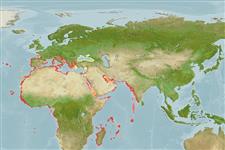>
Carangiformes (Jacks) >
Carangidae (Jacks and pompanos) > Trachinotinae
Etymology: Lichia: Greek, lichia = corpse like skin colour.
More on author: Linnaeus.
Environment: milieu / climate zone / depth range / distribution range
ນິເວດວິທະຍາ
ສັດທະເລ; ນ້ຳກ່ອຍ; ປາທີ່ມີການເຄື່ອນຍ້າຍໃນສະເພາະມາະຫາສະມຸດ (Ref. 51243); ລະດັບຄວາມເລິກ 0 - 50 m (Ref. 3197). Subtropical; 47°N - 28°S
Eastern Atlantic: southern Bay of Biscay to South Africa, including the Mediterranean. Western Indian Ocean: South Africa to Maputo Bay, Maputo (Mozambique)..
Length at first maturity / ຂະໜາດ / ນ້ຳໜັກ / Age
Maturity: Lm ?, range 60 - ? cm
Max length : 200 cm TL ຕົວຜູ້/ບໍ່ມີເພດ; (Ref. 57392); common length : 100.0 cm TL ຕົວຜູ້/ບໍ່ມີເພດ; (Ref. 3197); ນ້ຳໜັກສູງສຸດທີ່ເຄຍຈັດພີມມາ: 50.0 kg (Ref. 27584)
ຄີ (ໜາມ)ແຂງຢູ່ຫຼັງປາ (ທັງໝົດ): 8; ຄີຫຼັງຂອງປາ (ຄີອ່ອນ) (ທັງໝົດ): 19-21; ຄີ(ໜາມ) ແຂງຢູ່ຄີກົ້ນປາ
ກຸ່ມປາກະດູກແຂງ
ຄວາມຖີ່ຂອງກຸ່ມຖ່າຍທອດພັນ
ປາທີ່ມີການເຄື່ອນຍ້າຍຈາກທະເລໄປຫານ້ຳຈືດ ແລະນ້ຳຈືດຫາທະເລ
ປາທີ່ມີການເຄື່ອນຍ້າຍຈາກທະເລແລະໄປໄຂ່ຢູ່ນ້ຳຈືດ
ຄີກົ້ນຂອງປາ
ສັດທີ່ມີກະດູກສັນຫັຼງ
ການຖ່າຍທອດທາງກຳມະພັນຈາກພໍ່ແມ່ຫາລູກ 3; ຄີກົ້ນຂອງປາ: 17 - 21. Diagnosis: body elongate, moderately deep and compressed; dorsal profile of head almost straight, ending in a pointed snout; eyes relatively small; upper jaw slender and rounded posteriorly, ending below or beyond posterior eye margin; 2 dorsal fins, 1st with 7 spines with only their bases connected by a membrane, 2nd with 1 spine and 19-21 soft rays; anal fin with 2 detached spines followed by 1 spine and 17-21 soft rays; pectoral fins short, comprised 1.5-1.8 times in head length; scales small, those on breast oval to strongly lanceolate, and partially embedded in the skin; lateral line very irregular and wavy, describing a convex curve over, and a concave curve behind pectoral fins; no lateral-line scutes (Ref. 57392). Brown above, silvery white below lateral line; lobes of dorsal and anal fins black distally; juveniles (to at least 12 cm fork length) with brownish black bars on sides (Ref. 3197, 57392).
Marine, coastal pelagic species (Ref. 57392). Adults are found in coastal waters including estuaries. Occasionally entering lower reaches of rivers like the Kunene and Orange Rivers in Namibia (Ref. 52863). Juveniles often entering estuaries (Ref. 57392). Feed mainly on fish; juveniles prefer crustaceans (Ref. 4332). Eggs are pelagic (Ref. 4233). Popular game fish (Ref. 3197).
Smith-Vaniz, W.F., 1986. Carangidae. p. 815-844. In P.J.P. Whitehead, M.-L. Bauchot, J.-C. Hureau, J. Nielsen and E. Tortonese (eds.) Fishes of the north-eastern Atlantic and the Mediterranean. UNESCO, Paris. vol. 2. (Ref. 4233)
IUCN Red List Status (Ref. 130435)
Threat to humans
Harmless
Human uses
ການປະມົງ: ເປັນສີນຄ້າ; ຊະນິດປາທີ່ຖືກນຳໃຊ້ເຂົ້າໃນການຫາເພື່ອເປັນເກມກິລາ: ແມ່ນ
ຂໍ້ມູນຕື່ມອີກ
ເອກະສານອ້າງອີງການລ້ຽງສັດນ້ຳຂໍ້ມູນການລ້ຽງສັດນ້ຳສາຍພັນກຳມະພັນElectrophoresesການຖ່າຍທອດທາງກຳມະພັນຈາກພໍ່ແມ່ຫາລູກພະຍາດການປຸງແຕ່ງNutrientsMass conversion
ເຄື່ອງມື
Special reports
Download XML
ແຫຼ່ງອີນເຕີເນັດ
Estimates based on models
Preferred temperature (Ref.
123201): 16.2 - 29, mean 26.3 °C (based on 478 cells).
Phylogenetic diversity index (Ref.
82804): PD
50 = 1.0000 [Uniqueness, from 0.5 = low to 2.0 = high].
Bayesian length-weight: a=0.01349 (0.00996 - 0.01827), b=2.94 (2.85 - 3.03), in cm total length, based on LWR estimates for this species (Ref.
93245).
ຊັ້ນເຂດຮ້ອນ (Ref.
69278): 4.5 ±0.8 se; based on diet studies.
ຄວາມຢືດຢຸ່ນ (Ref.
120179): ຂະໜາດກາງ, ປະຊາກອນຕຳ່ສຸດທີ່ໃຊ້ເວລາສອງເທົ່າ 1.4 - 4.4 ປີ (Assuming tm=2).
Prior r = 0.51, 95% CL = 0.34 - 0.76, Based on 1 stock assessment.
Fishing Vulnerability (Ref.
59153): Very high vulnerability (90 of 100).
Climate Vulnerability (Ref.
125649): High vulnerability (57 of 100).
Nutrients (Ref.
124155): Calcium = 36.6 [20.7, 79.3] mg/100g; Iron = 1.26 [0.69, 2.33] mg/100g; Protein = 20.5 [19.3, 21.7] %; Omega3 = 0.346 [0.200, 0.608] g/100g; Selenium = 24.1 [12.4, 44.8] μg/100g; VitaminA = 9.68 [2.53, 33.46] μg/100g; Zinc = 0.526 [0.372, 0.751] mg/100g (wet weight);
